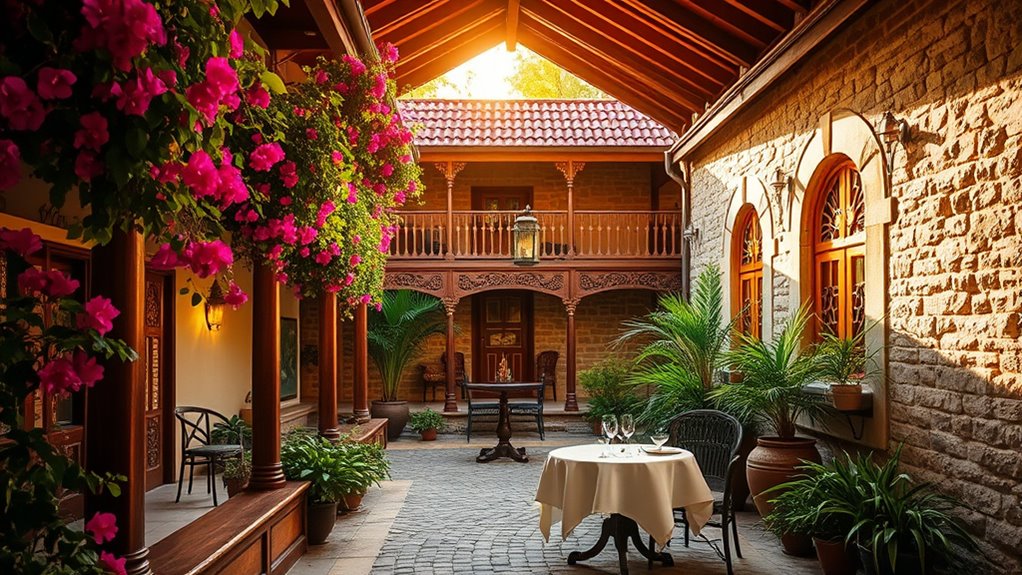Filipino architecture inspires romantic settings through its enchanting blend of history and culture. Colonial churches stand as majestic monuments, while Intramuros enchants with its narrow streets and charming Bahay na Bato. The Bahay Kubo embodies community spirit, inviting interactions that foster warmth. Art Deco theaters add a touch of glamour to the experience. With modern adaptations maintaining traditional elements, the beauty of these structures creates a unique ambiance perfect for romance. There’s much more to explore!
Key Takeaways
- Colonial churches with ornate Baroque elements create a majestic backdrop for romantic moments and significant life events.
- Intramuros’ narrow cobblestone streets and charming architecture evoke nostalgia, perfect for leisurely strolls with loved ones.
- The Bahay Kubo’s open design fosters intimacy and connection, making it an ideal setting for family gatherings and celebrations.
- Art Deco theaters offer glamorous venues for events, infusing romance with their elegant interiors and historical charm.
- Modern adaptations of traditional styles maintain a connection to nature, creating serene and inviting spaces for romantic living.
The Allure of Colonial Churches
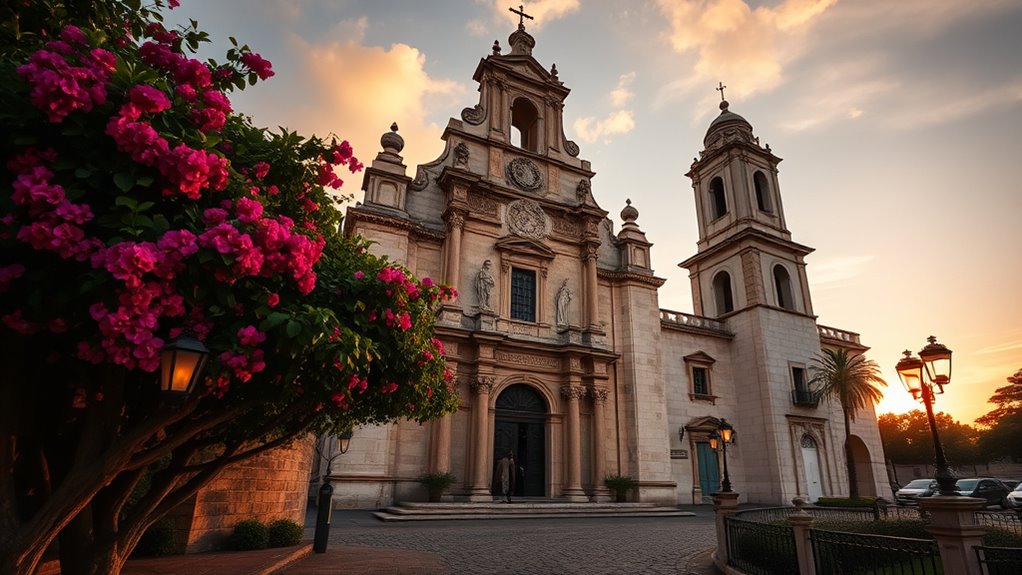
As you wander through the Philippines, you can’t help but be captivated by the allure of colonial churches, which stand as majestic monuments to the country’s rich history.
These fortress-like structures, built to withstand earthquakes and protect against marauding pirates, showcase an incredible blend of Spanish architectural influence and local adaptations. Constructed from durable stone or brick, they feature high Baroque elements like ornate retablos and decorative pediments.
Fortress-like churches blend Spanish architecture with local adaptations, showcasing Baroque elements and enduring craftsmanship.
You’ll notice intricate details, such as local flora reliefs, that beautifully merge indigenous culture with Catholic iconography. Each church tells a story, reflecting the craftsmanship of various religious orders while serving as essential community centers.
Their historical significance and architectural diversity make them true cultural treasures of the Philippines.
The Romantic Charm of Intramuros

The Romantic Charm of Intramuros
Intramuros exudes a romantic charm that captivates visitors with its blend of history and architecture. As you stroll through its narrow cobblestone streets, you can’t help but feel a sense of nostalgia. The iconic Bahay na Bato showcases a mix of European and local styles, while Casa Manila’s lush courtyards offer serene retreats. At night, the soft glow of lights enhances the enchanting atmosphere, making it perfect for a romantic evening. To further enhance the ambiance, you might consider incorporating cozy textiles that evoke a sense of warmth and comfort, reminiscent of the inviting farmhouse bedrooms. Additionally, the use of natural materials like wood and stone in the architecture adds to the area’s rustic charm. Furthermore, the warmth of the community is reminiscent of seniors texting humor, bridging generations through shared experiences.
Not to mention, cultural festivals bring the area to life, adding vibrancy to its historical significance. With every corner you turn, the intricate woodwork and ornate details whisper tales of the past, inviting you to immerse yourself in its timeless allure. The craftsmanship seen in these structures often reflects the artistry of refinishing wood furniture, highlighting the skill and dedication of local artisans.
Nostalgia and Community in Bahay Kubo
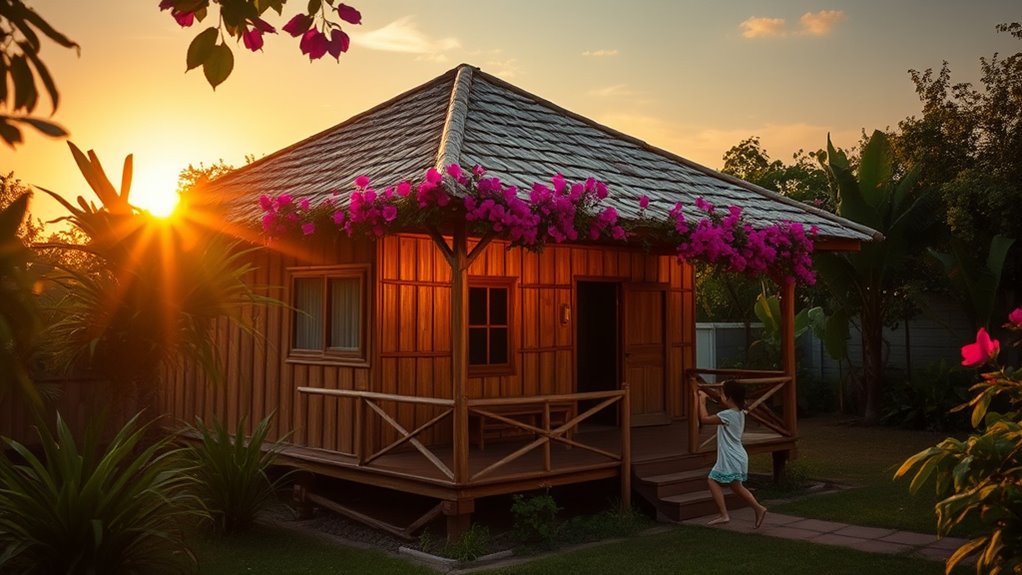
The charm of Filipino architecture continues with the iconic Bahay Kubo, a structure that evokes a deep sense of nostalgia and community.
The Bahay Kubo captures the essence of Filipino culture, fostering community and nostalgia through its simple yet iconic design.
Built from local materials like wood and bamboo, its simplicity reflects a humble lifestyle that many can relate to. Raised on stilts, the Bahay Kubo not only protects against floods but also creates a unique living space that separates you from the ground.
Its open design fosters interaction among family members, encouraging shared activities and a strong sense of belonging. The Bayanihan tradition of moving homes together reinforces community bonds, making the Bahay Kubo a cultural icon that symbolizes resourcefulness and the spirit of togetherness.
It’s this enduring legacy that inspires modern designs focused on communal living.
The Elegance of Art Deco Theaters

Art Deco theaters in Manila exude a fascinating elegance that transports you to a bygone era of glamour and sophistication. You can’t help but admire their luxurious designs, where smooth curves and lavish interiors create an enchanting atmosphere.
Iconic structures like The Met and the Capitol Theater showcase local motifs, reflecting the unique Filipino identity within global trends. Designed by renowned architects like Pablo Antonio and Juan Nakpil, these theaters became vibrant cultural hubs, hosting high-profile events and offering the best in entertainment.
Their historical significance is undeniable, symbolizing Manila’s cultural and economic growth during the 1930s. As preservation efforts continue, these theaters remain essential links to the past, enchanting visitors and reminding you of Manila’s rich architectural heritage. Investing in cultural preservation can enhance community identity and pride while safeguarding these architectural treasures for future generations.
Nature and Architecture: A Harmonious Blend
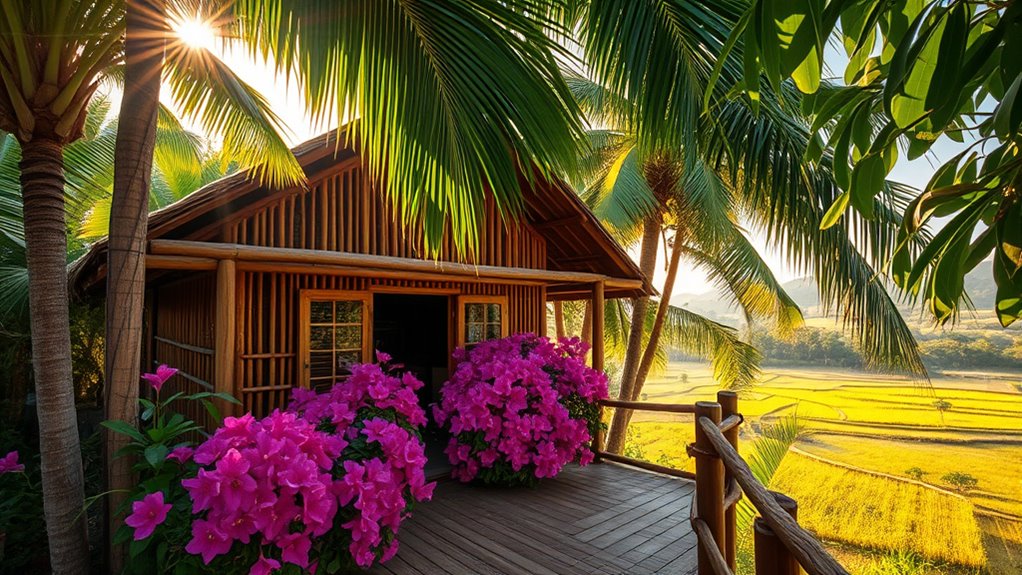
While exploring Filipino architecture, you’ll notice how seamlessly it blends with nature, showcasing a profound respect for the environment.
Traditional homes like the *Bahay Kubo* stand elevated, protecting against floods while facilitating natural ventilation. These structures utilize local materials such as bamboo and nipa palm, reflecting an understanding of the tropical climate.
Traditional *Bahay Kubo* homes elevate living spaces, harnessing local materials and natural ventilation to thrive in the tropical climate.
You’ll appreciate the large windows and open designs that enhance air circulation, reducing energy needs and promoting eco-friendliness.
This architectural style not only adapts to local landscapes but also embodies a strong cultural identity, reinforcing a connection with nature.
Modern Adaptations of Traditional Styles
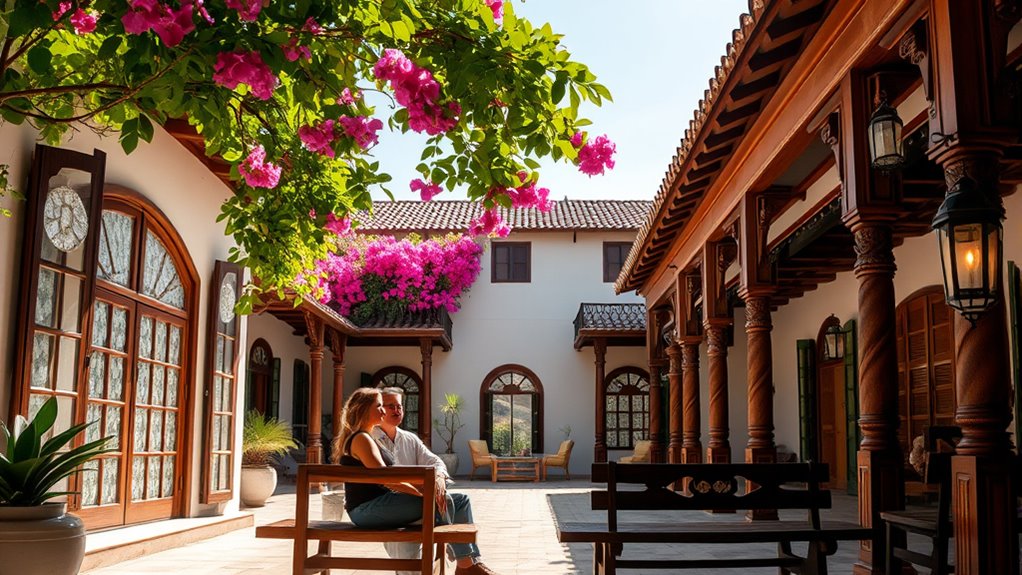
As modern life evolves, Filipino architects are creatively adapting traditional styles to meet contemporary needs without losing their cultural essence.
You’ll notice features like ventanillas in modern homes, allowing for airflow control to keep you comfortable in the tropical climate. Large windows enhance your connection to nature, flooding spaces with light and offering stunning views.
Inspired by the bahay kubo, open layouts promote effective cross ventilation, reducing reliance on air conditioning. Architects often use natural materials like nipa palm and bamboo, ensuring a sustainable approach.
Elevated structures protect against floods while preserving the traditional aesthetic. This blend of tradition and modernity not only honors cultural heritage but also embraces sustainable practices, creating beautiful, functional spaces for today’s lifestyle.
The Impact of Romantic Tourism on Local Economies
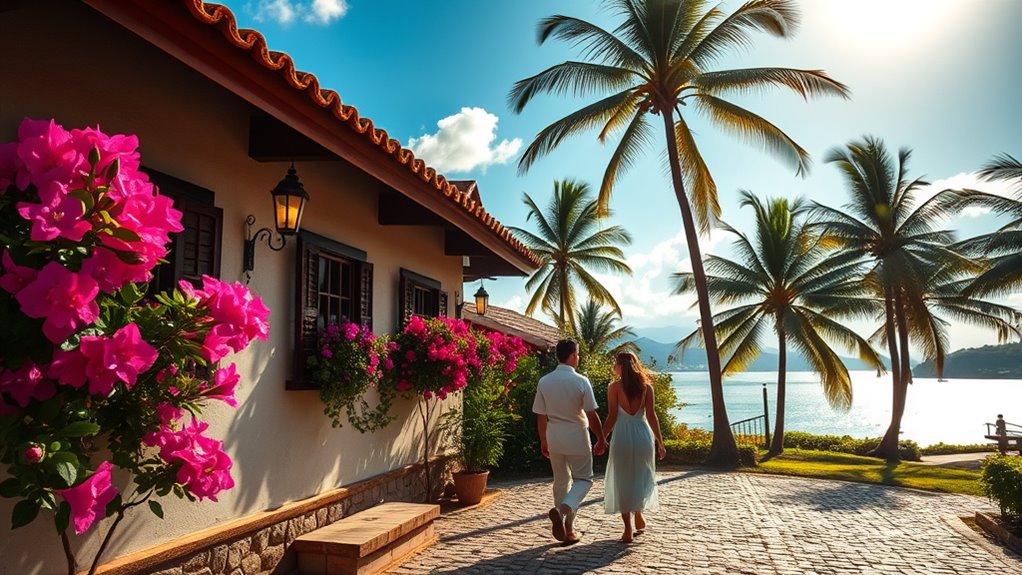
Romantic tourism greatly boosts local economies by creating opportunities for growth and development. When you invest in tourism, you often see a return of up to $10 for every dollar spent on marketing.
This influx of visitors leads to job creation in hospitality and transportation sectors, enhancing local employment. Furthermore, tourism drives infrastructure improvements like roads and airports, benefiting both residents and travelers.
It encourages private sector investments in local businesses, fostering entrepreneurship and small business growth. Additionally, tourism supports cultural and historical preservation, ensuring that local heritage remains intact.
As you engage with these romantic settings, you also promote sustainable practices that protect natural resources, making tourism an essential component of economic and environmental health.
Frequently Asked Questions
What Are the Best Times to Visit These Romantic Architectural Sites?
The best times to visit romantic architectural sites are from November to April. During this dry season, you’ll enjoy warm, sunny days perfect for outdoor exploration.
December to February is peak season, offering festive celebrations and ideal weather. Consider timing your visit with cultural festivals like Ati-Atihan or Sinulog for an added romantic touch.
Early mornings or late afternoons will help you avoid crowds, making your experience even more intimate and enjoyable.
How Can I Incorporate Filipino Architecture Into My Wedding Theme?
To incorporate Filipino architecture into your wedding theme, focus on fascinating features like vintage venues and vibrant details.
Select spots like Casa Manila or Las Casas Filipinas for a stunning backdrop. Use local materials, like woven abaca, to enhance décor, and include traditional attire with butterfly sleeves.
Infuse the ceremony with cultural customs, creating a charming atmosphere that celebrates your heritage.
Are There Guided Tours Available for These Historical Buildings?
Yes, there are guided tours available for historical buildings in the Philippines.
You can explore Intramuros, where expert guides will share fascinating stories about landmarks like Fort Santiago and Manila Cathedral. These tours often include insights into architectural styles, enriching your understanding of Filipino culture.
Additionally, you might find tours focusing on Art Deco theaters, providing a unique glimpse into the country’s artistic heritage while appreciating the beauty of these structures.
What Unique Experiences Can Couples Find in These Romantic Settings?
You might think romantic settings are all about fancy dinners, but there’s so much more!
In the Philippines, you can stroll through the historic streets of Intramuros, visit stunning Baroque churches, or enjoy vibrant street performances.
Explore scenic parks or unwind at a rooftop bar with breathtaking views.
Each experience adds a layer of romance, whether you’re sharing a quiet moment at Fort Santiago or savoring local delicacies at a food festival.
Can I Book Private Events at These Architectural Sites?
Yes, you can book private events at various architectural sites, but it often requires specific permits and approvals.
For instance, venues like the Manila Cathedral and gardens within Intramuros are popular for events, but you’ll need to coordinate with local authorities.
Partnering with an event management service can streamline the process, ensuring you meet all necessary requirements.
Always check the current status of the venue to confirm availability and booking conditions.
Conclusion
In exploring the enchanting essence of Filipino architecture, you’ve discovered how these stunning structures spark romance and reflection. From the serene sanctuaries of colonial churches to the vibrant vibes of art deco theaters, each element evokes emotion and nostalgia. By embracing these beautiful buildings, you not only celebrate cultural heritage but also support sustainable tourism. So, as you wander through these wondrous wonders, let their charm and character cultivate connections that create cherished memories.
